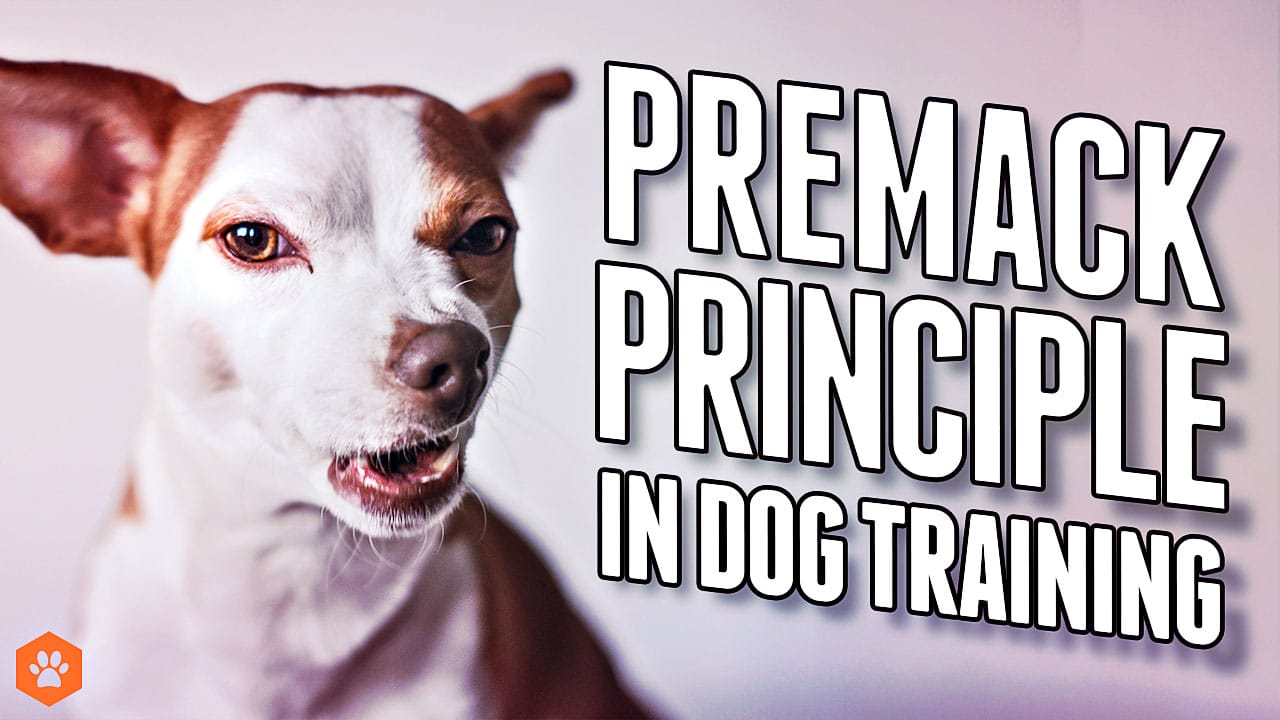How to effectively use the Premack Principle in your dog training
We love to train dogs with food and toys, but those are certainly not the only ways to approach good training. Indeed, those reinforcers are sometimes less effective than other strategies, depending on the context. Even when food and toys will work, you can still do other more compelling things. There’s always more than one way to peel an orange, and one of my favorite tactics is to use the Premack principle in dog training! Buckle up: we’re about to get a bit technical!
WHAT IS THE PREMACK PRINCIPLE ANYWAY?
The Premack principle—technically named the “Relativity theory of reinforcement”—was first proposed by David Premack in 1965 as a way to explain human behavior. He argued that people are more likely to engage in low-probability behaviors if reinforced by high-probability behaviors. In essence, offering something that would normally often happen in a free operant situation now becomes contingent upon something else that occurs with low frequency.
In other words, some desirable activity the learner would likely do frequently on their own, is now brought under some control so we can leverage it to build another behavior, a less desirable activity.
For example, the classic stipulation that you have to eat your broccoli if you want dessert is a time-tested Premack strategy that parents and grandmothers have been leveraging for centuries. Eating dessert would probably happen pretty often in a free operant situation. However, by placing it under some controlling capacity, we can use it to influence eating broccoli. Premack’s principle is also used in clinical settings. For example, a person who successfully loses weight may take a special trip to shop for new clothes. The experience of purchasing new clothes that fit better and improve the person’s self-image effectively reinforces their efforts at weight loss.
In another example, let’s say Emma loves swinging on a tree swing. However, she’s not too keen on doing her homework; it takes a lot of effort, and she doesn’t particularly enjoy it. We could tell Emma that after she does two pages of worksheets, she can use the swing for five minutes. Access to the swing could be a reinforcer for completing her homework. There are two components in these three equations:
- The instrumental response (the low probability behavior) is the target behavior you want: eating broccoli, losing weight, doing the homework, etc.
- The reinforcing or contingent response (the high probability behavior) will be your reinforcer: eating dessert, shopping for clothes, swinging, etc.
However, for setups like these to work effectively, dessert can’t be available at any other time, clothes shopping has to be an infrequent event, and Emma shouldn’t be able to sneak the swing at different times. External access like this is called bootlegging. It will reduce the value of dessert, shopping, and swing time because they’re available outside the dinner/weight loss/homework opportunities to access them.
So, the Premack principle operates on the response deprivation hypothesis, which states if opportunities are constrained, the behavior becomes more valuable. Therefore, intelligent use of Premack in training is contingent on reasonable control of the reinforcers in the environment.
USING THE PREMACK PRINCIPLE IN DOG TRAINING
As in Emma’s example, the Premack principle is often used in parent-training programs to encourage appropriate child behavior and discourage inappropriate behavior. Since owning a dog has a lot of continuity with raising a child, it’s possible to use the Premack principle for cracking some of those more difficult dog training problems.
We can use Premack in dog training by using behavior that the dog is more likely to do to reinforce a behavior that the dog is less likely to do. So, for example, if a dog wants to do something that isn’t very likely (like sit still), you can use something the dog is more likely to do (like sniff around) to reinforce your desired behavior.
Most of the setups where you’ll use Premack will involve life rewards and enrichment. This switches your approach so the environment can work with you instead of against you. Most people view the environment as something to overcome; it doesn’t need to be that way.
This concept can be mind-blowing for some dogs! Their previous notion of “I might be able to do what I want if I could get past you” evolves into “I might be able to do what I want if I can make you happy.” However, it is crucial to remember that the reward must be something the dog wants and that you have some reasonable control over. If the reward is not something the dog values, it will not work as a reinforcement.
PRACTICAL EXAMPLES FOR TRAINING DOGS
1. Drop It
Drop it is a perfect Premack opportunity. When I play tug with a dog, for example, we’ll say “Drop It” or “Out” (my preferred prompt) and then immediately immobilize the toy. Now the game becomes dull and non-rewarding, and I wait the dog out. The precise instant they release, I mark “Yes!” and pop back into action.
The instrumental response (releasing the toy) is reinforced by resuming the game; the dog turns the game back on by letting go, and so the dog learns to release the toy ASAP! The feeling of control they have over the game is a potent reinforcer! You can teach a drop during fetch, too.
If you can get your hands on the ball, you can do it just like in tug by waiting them out and throwing it right away again when they release it. Otherwise, you can use the ol’ “Two-Ball” method, where you have two identical balls. Throw the first, and load up the second like you’re going to throw it. When your dog comes close with the first one in their mouth, say “Drop It” and wait. The instant they drop the first one, mark “Yes!” and huck the second ball. It won’t take long for most dogs to build instantaneous drops in both the tug and fetch setups.
2. Exploration and Engagement: the Toy Store Hack
Outdoor time is an enriching experience for many dogs. However, rather than totally disconnecting and making it a solo experience for your dog, you can make it a more valuable social experience for both of you. Many owners complain they can’t get their dog’s attention and attempt to butt in too much. Unfortunately, this chronic interference can actually push your dog further away. It’s much more effective to use the exploration your dog badly wants to do to cultivate the interactivity you want.
Premack principle to the rescue!
The low probability behavior—the instrumental response—is engagement with the owner, and the reinforcing behavior is getting to explore some more. If you allow your dog to do most of the driving (as long as it’s safe), you can capture little nuggets of attention. From there, it’s a simple process of free-shaping to supersize these while using the very behavior that used to annoy you to get them! Look at my eBook on the Toy Store Hack to learn how to use Premack during sniff ‘n’ stroll time!
3. Come
Our first Come training exercise (after Simpawtico’s “Free-Engagement”) is the Free-Call drill. It’s actually an extension of the Toy Store Hack from above. In the Free-Call setup, you also allow your dog to explore the environment freely. Then you call them from a short distance, have a huge reward event, and send them off to continue snooping around. Exploring becomes part of the reward structure, so coming when called becomes a fun interlude that leads to more exploration. Please read the Recall Training article for more information on using Premack in training Come.
4. Treat-Retreat
Treat-Retreat is a strategy developed by the acclaimed trainer and behavioral consultant Suzanne Clothier for working with socially uncomfortable and fearful dogs. In this approach, we toss a piece of food close to us and immediately throw another far away when the dog takes the close one. The (less likely) instrumental response is coming closer to us to get the first piece of food. The (more likely) reinforcing response is increasing social distance by moving away.
However, by having the dog engage in chasing to access the food we threw over their head, we’re substituting a seeking response for a flight response—it’s functionally equivalent. Still, it changes the way the dog interacts with the environment. Treat-Retreat is powerful stuff and works surprisingly well. It doesn’t take long before a timid dog feels more comfortable in the space and may even initiate contact with someone. I use it weekly with dogs at the Simpawtico training center and the shelter. Learn more about this powerful strategy on Suzanne’s website so you can start using it.
5. Fence Running
Fence running is a common issue among dogs. They see something interesting on the other side of the fence and can’t resist getting a closer look. This can be hazardous as their arousal and frustration can increase over time and activate other behaviors. If the barrier is compromised in any way, the dog may run into traffic or get lost. One way to resolve this issue is to use the Premack Principle. With appropriate safety layers in place (such as using a leash), allow your dog to get a good look at things on the other side of the fence. Like the Toy Store Hack above, all you need is to stay on their radar and validate the experience for your dog. You can reinforce any-and-all engagement with you by allowing your dog to check it out again.
For low-level versions, you can move right up to the fence with them and back again, doing a rubber band maneuver where they check the stimulus and then bounce back with you repetitively, allowing you to pattern the behavior quickly.
PRO TIP: just like going to the gym, your number of repetitions determines how quickly you reach your goals! For a higher level of arousal, use your leash (or some other safety layer) to work with them at a distance where your dog can remain under threshold. Make sure to check the caveats below!
6. Alarm Barking: Validate their barking ticket!
Often a dog needs upper management to acknowledge sudden environmental contrasts (SECs). They need you to step up and say, “I got it; I appreciate you letting me know.” Then, we can more easily direct them to the next thing.
Since so much in the modern world is stimulating to dogs, they often find it difficult to understand what is happening around them. That’s why we need to accompany them as things happen and help explain it to them using words and phrases to help them make sense of the world.
- “Did you hear something, buddy?”
- “Uh-oh, what is it? Let’s check it out.”
By being present and validating your dog’s experience, you’re opening communication channels. This makes it easier for you to capture re-engagement, redirect, and motivate them toward alternate opportunities for reinforcement.
In this example, the more probable behaviors include barking and investigating. In contrast, the less probable behaviors include engaging with you (usually with a head turn) and finally moving away from you. When you can capture these things, you have to mark “Yes!” and pop into a reward-event. Then, allow your dog to go back and do it again.
Remember: as with all things in dog training, it’s all about banging out the repetitions. It’s never “one and done” until you reach your end goals with any given behavior your dog learns.
Usually, when I teach this procedure to owners, they report that within a few days the most they get out of their dog is one or two chuffs, and then they’re done.
I discuss this concept more in the “Barking Decoded” eBook!
7. Training with food
Think about it: we reinforce most behaviors in a reward-based system by handing out food treats. Eating is a reinforcing behavior, and the things we reward them for doing are instrumental behaviors. So, in essence, that’s Premack too!
See also: How to Use Reward Scaling
8. What else?
There are innumerable Premack principle-styled training setups possible. As long as you:
- Are aware of the hierarchy of reinforcers (what’s most reinforcing for your dog in the environment),
- Have reasonable control of access to those reinforcers in and outside of training sessions,
- Can link those reinforcers functionally to your instrumental response…
…you can use the Big Premack as the SECRET SAUCE to accelerate your training efforts!
PREMACK-ATTACK: CAUTIONARY CAVEATS
“When it works for you, you control access to environmental reinforcers. When it works against you, the dog controls access to environmental reinforcers and learns the owner is irrelevant in distracting environments.” Dr. Ian Dunbar
As I mentioned earlier, it’s important to maintain reasonable control over reinforcers. If your dog has free access to all the things you could potentially use as a reinforcer, they’re bootlegging and denaturing the effectiveness of those things in a training setup.
So, for example, in “Drop it” training, don’t leave the interactive toys around where your dog can learn to play with them without you (as I talked about in the Types of Toys post). Pick them up so they’re restricted access—your dog will have to go through you to get them. Likewise, don’t allow your dog to run in the backyard unsupervised, or your fence running work will stall. If your dog can run the fence making noise and carrying on, it is self-reinforcing. You have to limit access to these things, especially when problem behaviors are involved.
Don’t Trigger Big Feelings
The Premack principle may not be suitable when the instrumental response (the desired behavior) triggers stress or arousal. For example, if your dog chases squirrels, you don’t necessarily have to let them chase the squirrels as a reinforcing behavior. This is unfairly terrifying for the squirrel, and the fulfillment of chasing behavior is so arousing that you can quickly paint yourself into a corner. Chasing like that creates a massive dopamine hit, releasing a flood of feel-good chemicals in your dog’s brain; it’s hard to dissuade them from the chase if they have practiced it many times because they’ve essentially become an addict.
Alternatively, looking at squirrels begins to satisfy the “eye-orient” stage of the predatory sequence. Allowing your dog to indulge in just looking is usually sufficient to reinforce engagement with you. It’s much safer and keeps a cap on their overall arousal. There’s no need to allow them to follow through into the chase part; many dogs are too deep into their arousal to productively come back from that (which plays into keeping dogs under threshold in the first place).
The “Validating their Barking ticket” strategy above uses similarly truncated versions of the alarm behavior. We don’t necessarily have to let them bark their heads off when they sense a sudden environmental contrast. We must encourage them to do minor investigative behaviors—eye-orient, air scenting, etc.
Incidentally, you can deploy many of these abbreviated versions of noticing things in the environment when the stimulus is other dogs. That’s how we work through reactivity at Simpawtico. This application of the Premack principle also forms the basis of Leslie McDevitt’s “Look at That” drill and Alice Tong’s “Engage-Disengage.”
Don’t try to USE big feelings, either
Likewise, Premack is a terrible setup if the desired behavior results from fear, stress, or a heavy-emotional load. For example, don’t force a fearful dog to interact with people. You could easily trigger a fight-or-flight response. Similarly, don’t force a fearful dog to go into a crate if they’re resistant; that’s not at all effective crate training. The Treat-Retreat protocol I mentioned above has specific, low-impact criteria to do it right, and we work hard to keep the dog under the threshold at all times.
Finally, you shouldn’t allow unfettered access to annoying behaviors. You don’t necessarily always have to use a behavior you’re trying to diminish as the reinforcer. Sometimes the behavior you’re working on is so annoying that allowing them to indulge in it doesn’t make sense. Jumping perfectly illustrates this caveat; again, trimmed-down versions of interactivity will likely serve as functional substitutes.
Bring In The Big Guns If You Have To
If any of the behaviors you’re dealing with are what might be termed “big behaviors”—aggression, anxiety, profound fear—do yourself a favor and bring in a certified dog trainer or behavioral consultant. Cases like these have more sticky, moving parts than just a creative training setup. A knowledgeable pro can help you iron out those kinks. You and your canine companion don’t have to go it alone!
CONCLUSION: MANAGING WHAT YOUR DOG LEARNS
Dogs are always learning, whether you want them to or not. It’s up to us to pay attention in a given scenario and help them navigate the world with confidence and stability. Whether you’re using great treats, toys, life rewards, praise, petting, or any combination thereof (plus more!), you have a lot of tools at your disposal. Premack’s format is a powerful option that should be fully explored and utilized.
There you have it, folks. I hope this introduction to the Premack principle has ignited your imagination and spurred you to think about new ways to work with your dog training. As I said, there are countless ways to apply this principle. It’s a stupendous way to look at those more probable behaviors and use them strategically to reinforce less probable behaviors. For some training situations and some dogs, it’s the best in-road you have at your disposal.
So try it out, and let me know how it’s going for you in the comments. Keep learning, keep practicing, and happy training. Thanks for reading!











Trackbacks for this post